|
|
|
Sort Order |
|
|
|
Items / Page
|
|
|
|
|
|
|
| Srl | Item |
| 1 |
ID:
119388
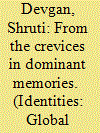

|
|
|
|
|
| Publication |
2013.
|
| Summary/Abstract |
Dominant collective memories around the anti-Sikh violence of 1984 are mostly dichotomous. The official state memories of 1984 are replete with omissions about the attack on Sikhs and several human rights violations. On the other hand, the counter-mobilisations that developed in the aftermath of 1984 are largely focused on the demand for a separate state of Khalistan. I problematise these dichotomous framings by examining what I call present-day 'virtual commemorative crevices'. I suggest that these crevices are transnational, sacred or set-apart and liminal fissures in hegemonic memories and institutionalised forms of commemoration. I examine eight websites focusing on 1984 and the role of the Sikh diaspora in disrupting older temporal fixities and spatially rooted narratives. Virtual fissures mark a subtle, but significant shift from polarised hegemonic narratives to a more differentiated, future-oriented activism.
|
|
|
|
|
|
|
|
|
|
|
|
|
|
|
|
| 2 |
ID:
109139
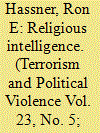

|
|
|
|
|
| Publication |
2011.
|
| Summary/Abstract |
Sacred rituals and symbols can act as force multipliers that motivate and constrain the effectiveness of actors. Religious intelligence involves an assessment of how these rituals and symbols affect combat operations. The fourfold challenge faced by the religious intelligence analysts is to ascertain how prominent a role religion will play in a given conflict, what the relevant sacred phenomena are, how salient they are for the specific religious communities present, and how they will affect a given conflict. The case studies that form the core of this article highlight three issue areas open to religious intelligence collection and analysis, and exhibit variation in the ability of intelligence analysts to correctly assess those religious factors. Egyptian and Israeli decision making prior to the 1973 Arab-Israeli War illustrates how information about sacred time can influence war initiation. The diverging outcomes of two counterinsurgency operations at the same sacred site, "Operation Blue Star" (1984) and "Operation Black Thunder" (1988), demonstrate the utility of intelligence about the parameters of sacred space. A final case study explores the U.S. failure to grasp the importance of religious authority in the Iranian Revolution. I conclude by considering the actors best suited for gathering and processing religious intelligence. Religious intelligence requires interdisciplinary teams that combine expertise in religion, area studies, and military operations.
|
|
|
|
|
|
|
|
|
|
|
|
|
|
|
|
| 3 |
ID:
142108
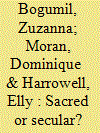

|
|
|
|
|
| Summary/Abstract |
The reconstruction of the history from the late 1980s to the mid-1990s of Soviet repressions critically influenced the social formation of Gulag memory in Russia. Amongst those re-narrating the past, the ‘Memorial’ Society and the Russian Orthodox Church most actively shaped the collective memory of Soviet repressions, trying to establish multi-layered explanatory constructs of the Gulag. Their interpretations were crystallised through contemporary memorialisation acts in significant landscapes of the past. Focusing on Solovki, Ekaterinburg, Butovo and Magadan, and analysing tensions in their memorialisation processes, we discuss secular and Orthodox interpretations of the Gulag, and their impact on the memory of the Soviet repressions in contemporary Russia.
|
|
|
|
|
|
|
|
|
|
|
|
|
|
|
|
| 4 |
ID:
139683
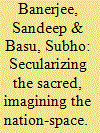

|
|
|
|
|
| Summary/Abstract |
This article examines changing conceptions of the Himalaya in nineteenth-century Bengali travelogues from that of a sacred space to a spatial metaphor of a putative nation-space. It examines sections of Devendranath Tagore's autobiography, written around 1856–58, before discussing the travelogues of Jaladhar Sen and Ramananda Bharati from the closing years of the nineteenth century. The article argues that for Tagore the mountains are the ‘holy lands of Brahma’, while Sen and Bharati depict the Himalaya with a political slant and secularize the space of Hindu sacred geography. It contends that this process of secularization posits Hinduism as the civil religion of India. The article further argues that the later writers make a distinction between the idea of a ‘homeland’ and a ‘nation’. Unlike in Europe, where the ideas of homeland and nation overlap, these writers imagined the Indian nation-space as one that encompassed diverse ethno-linguistic homelands. It contends that the putative nation-space articulates the hegemony of the Anglo-vernacular middle classes, that is, English educated, upper caste, male Hindus where women, non-Hindus, and the labouring classes are marginalized.
|
|
|
|
|
|
|
|
|
|
|
|
|
|
|
|
| 5 |
ID:
180639
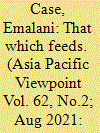

|
|
|
|
|
| Summary/Abstract |
Sponsored by the Asia Pacific Viewpoint, this paper was originally delivered as a keynote address at the New Zealand Geographical Society (NZGS) conference in November of 2020. Building on the conference theme, ‘Embracing Diversity: Expanding Geographies’, it argues that any consideration of our diverse, layered and growing environments must consider the sacred. Rather than focus solely on what are often deemed ‘sacred’ sites – or those places marked by physical signposts, particular rituals or sanctioning – it encourages us to think deeply about the everyday sacred though recognising how places feed. Flowing between places and times, between Kumutoto Stream in Te Whanganui-a-Tara and Pōhakuloa in Hawaiʻi, this paper is a call to stand on whenua and see it, smell it, taste it and love it. It is an invitation to relate to place on an intimate level. It is a prompting to be critical of the urban and colonially constructed spaces that have become naturalised in our daily lives and to uncover the stories, histories and peoples they work to displace and erase so that we can plant collective roots of resistance and solidarity for better futures.
|
|
|
|
|
|
|
|
|
|
|
|
|
|
|
|
| 6 |
ID:
148935
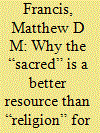

|
|
|
|
|
| Summary/Abstract |
The popular media and many in academia often overstate the role that religion, and its supposedly unique qualities, has played in recent acts of terror. In this article, I argue that the notion of religious violence is unhelpful and that there is a more useful concept that we can utilize to draw out the values and ideas that play a role in the move to violence in both religious and secular groups. From a series of case studies on religious and non-religious groups, I have drawn out an alternative framework for investigating and learning from the role that beliefs play in motivations and justifications for terrorism. This framework uses the concept of non-negotiable (or “sacred”) beliefs. It is as applicable to secular as it is to religious groups, and can show us much more about how such beliefs can contribute to violence.
|
|
|
|
|
|
|
|
|
|
|
|
|
|
|
|
|
|
|
|
|